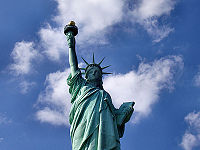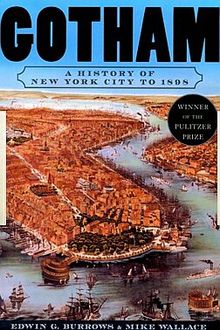Difference between revisions of "New York City"
m (wikilink) |
(→History: linked cosmopolitan) |
||
| Line 29: | Line 29: | ||
== History == | == History == | ||
| − | The first Dutch settlers arrived on Manhattan in 1624, naming the town New Amsterdam. Indian claims were bought out for the equivalent of $24. The Dutch sent settlers up the Hudson River (which is easily navigable by sailing vessels) to Albany. The Dutch colony, named New Amsterdam, was run in autocratic fashion by Governor Peter Stuyvesant. It soon had a cosmopolitan flavor, with freedom of religion and numerous ethnic and religious groups; the Dutch brought slaves as house servants.<ref>Slavery was finally abolished in 1799.</ref> The city was captured in war by the British in 1664; they renamed both the city and the colony for the Duke of York (who later became King [[James II]]). | + | The first Dutch settlers arrived on Manhattan in 1624, naming the town New Amsterdam. Indian claims were bought out for the equivalent of $24. The Dutch sent settlers up the Hudson River (which is easily navigable by sailing vessels) to Albany. The Dutch colony, named New Amsterdam, was run in autocratic fashion by Governor Peter Stuyvesant. It soon had a [[cosmopolitan]] flavor, with freedom of religion and numerous ethnic and religious groups; the Dutch brought slaves as house servants.<ref>Slavery was finally abolished in 1799.</ref> The city was captured in war by the British in 1664; they renamed both the city and the colony for the Duke of York (who later became King [[James II]]). |
[[File:Nyc2.jpg|thumb|450px|Manhattan neighborhoods]] | [[File:Nyc2.jpg|thumb|450px|Manhattan neighborhoods]] | ||
The use of [[Ellis Island]] as the checkpoint for millions of European immigrants in the late 19th Century caused New York City's population to swell, as many settled in the city. | The use of [[Ellis Island]] as the checkpoint for millions of European immigrants in the late 19th Century caused New York City's population to swell, as many settled in the city. | ||
Revision as of 07:04, January 18, 2018
| New York City | |
|---|---|
|
| |
| Country | United States |
| State | New York |
| Settled | 1624 |
| Population | 8,405,837 |
| Area (sq mi) | 6,720 |
| Population density (/sq mi) | 27,778.7 |
| Current mayor | Bill de Blasio |
| Demonym | New Yorker |
| Co-ordinates | 40.8° N., 73.9° W.[1] |
New York City, officially the City of New York, is a city and metropolis in the state of New York, located on the East coast of the United States of America. New York City is known best for the New York Stock Exchange and financial district, its liberal media, its liberal Broadway shows, and its high cost of living. Shows broadcast from New York City include The Tonight Show Starring Jimmy Fallon, The Late Show with Stephen Colbert, Saturday Night Live and Fox News; New York City is also where the major networks grew in influence: ABC, CBS and NBC.
With a population of 19 million in the three-state metropolitan area (and 8,140,000 in the city as in 2005), it is the most populous urban area in the United States. The city is divided into five different counties, called boroughs. Manhattan is the financial, commercial, and tourist center. Brooklyn is the most populous of the boroughs, and suburban Queens is the largest in area. The other two boroughs are The Bronx, a downscale residential area, and suburban Staten Island. The modern city was formed in 1898 through a merger of the original New York City with Brooklyn.
New York City is the cultural capital of the world; it has global importance in fashion, finance, news, diplomacy, education, medicine and arts. The city is a world-class tourist destination. It contains many landmarks, including the Statue of Liberty, Wall Street, in Lower Manhattan, and many others. The city (along with its #2 rival Chicago) invented the skyscraper, and still has some of the tallest buildings in the world, like Empire State Building; the original World Trade Center towers were destroyed by Islamic terrorists in the September 11, 2001 attacks.Contents
Transportation
New York owes its success to its status as the major hub of world transportation by air and water. It grew because it has one of the world's finest natural harbors. It is ice-free year-round and deep enough to enable large ships to reach its piers regardless of the tide. The Port Authority of New York and New Jersey was established in 1921 by the two states in order to administer jointly the shared waterfront. Most traffic is now handled through containers. Three major airports serve the city: John F. Kennedy International Airport (for international travel) and La Guardia Airport (for domestic travel), as well as nearby Newark International Airport. All three airports are operated by the Port Authority, which also operates certain bridges, tunnels and subway lines that connect New York and New Jersey.
When Hurricane Irene was headed for the city in August 2011 following a harsh winter, the MTA (Metropolitan Transportation Authority) shut down all its commuter rail, subway and buses. This move was criticized by some as excessively cautious.
History
The first Dutch settlers arrived on Manhattan in 1624, naming the town New Amsterdam. Indian claims were bought out for the equivalent of $24. The Dutch sent settlers up the Hudson River (which is easily navigable by sailing vessels) to Albany. The Dutch colony, named New Amsterdam, was run in autocratic fashion by Governor Peter Stuyvesant. It soon had a cosmopolitan flavor, with freedom of religion and numerous ethnic and religious groups; the Dutch brought slaves as house servants.[2] The city was captured in war by the British in 1664; they renamed both the city and the colony for the Duke of York (who later became King James II).
The use of Ellis Island as the checkpoint for millions of European immigrants in the late 19th Century caused New York City's population to swell, as many settled in the city.
Politics
New York City is historically considered a liberal city, with the majority of the population voting Democrat. However, the mayor has recently been Republican, in the case of Rudy Giuliani or independent in the case of the liberal Michael Bloomberg. In November 2013, liberal Democrat Bill de Blasio was elected mayor and despite his anti-law enforcement rhetoric and liberal socialistic policies, was re-elected in November, 2017. Fox News Channel is based there in Manhattan. Of the 13 congressional districts that include parts of New York City, only one is represented by a Republican (Daniel M. Donovan, Jr. of Staten Island).
New York City has strict gun control laws and is rumored to make it hard for civilians to obtain even non lethal self-defense sprays.
Culture

New York City is home to top-notch museums in art, architecture, photography, natural history, television, radio and technology, like: The Metropolitan Museum of Art, Solomon R. Guggenheim Museum, The Frick Collection, the National Design Museum, the Museum of Natural History, and the National Academy Museum and School of Fine Arts.[3]
Featured cultural sites are:
•Lincoln Center for the Performing Arts
•Carnegie Hall
•Radio City Music Hall
•Hayden Planetarium
•New York Aquarium
•The Morgan Library
•New York Public Library
•Rose Center for Earth and Space
•International Center of Photography
•Empire State Building Lobby Gallery
•SculptureCenter
•Museum of Biblical Art
•Staten Island Institute of Arts & Sciences
•Center for Architecture
•Studio Museum in Harlem
Boroughs
Each of New York City's boroughs is coterminous with a county in the State of New York. The five boroughs are:
- Manhattan (New York County)
- Brooklyn (Kings County)
- Queens (Queens County)
- The Bronx (Bronx County)
- Staten Island (Richmond County)
Each borough elects its own borough President and district attorney. Unlike the London boroughs, the boroughs of New York City do not operate as local governments. All of the non-Manhattan boroughs are sometimes referred to collectively as "the outer boroughs" as they are arranged in a sort of semicircle around Manhattan. Each borough has its own court system, and two boroughs have separate public library systems.
Many places have been proposed as "Sixth Boroughs," which can carry a different meaning depending on who is asked. Some areas often cited as "Sixth Boroughs" include:
- Hudson County, New Jersey
- Nassau County, Long Island, New York
- Westchester County, New York
- Newark, New Jersey
- Philadelphia, Pennsylvania
See also
External links
- Museum of American Financial History.
- The Met.
- NYC ARTS.
- A Walking Tour of Rockefeller Center's Public Art.
Further reading
- Burrows, Edwin G., and Mike Wallace. Gotham: A History of New York City to 1898 (2000) excerpt and text search, the best history; Pulitzer prize
- Caro, Robert. The Power Broker: Robert Moses and the Fall of New York. (1973) excerpt and text search
- Jackson, Kenneth, ed. The Encyclopedia of New York City (1995), the best reference book; 1350pp; excerpt and text search
- Jackson, Kenneth and Sam Roberts, eds. The Almanac of New York City (2008)
- Kessner, Thomas. Fiorello H. LaGuardia and the Making of Modern New York (1989) the most detailed standard scholarly biography
- Slayton, Robert A. Empire Statesman: The Rise and Redemption of Al Smith, (2001), 480pp, the standard scholarly biography; excerpt and text search
References
- ↑ (1922) World Almanac and Book of Facts for 1923, series: World Almanac and Book of Facts (in English). New York: Press Pub Co. (The New York World), 63. Rounded down toward zero.
- ↑ Slavery was finally abolished in 1799.
- ↑ Museums in New York City






